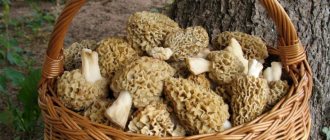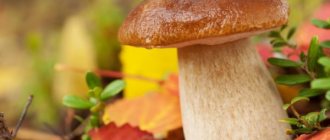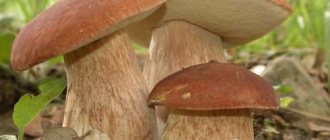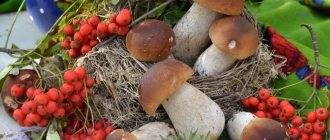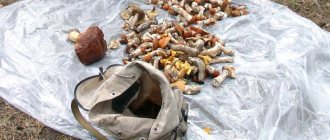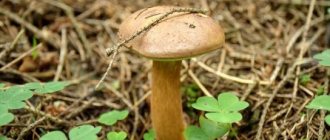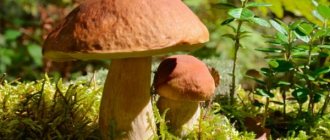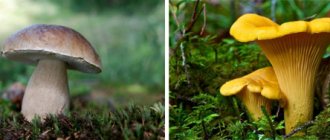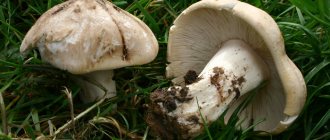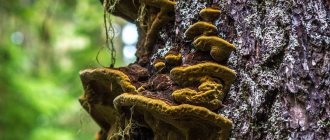Autumn is the ideal time of year for collecting mushrooms, since more dew forms at night and the soil layer is moistened. Under such favorable conditions, boletuses and boletuses begin to grow out of the ground in huge numbers. It is in the fall that you can collect a rich harvest of forest gifts and make preparations for the winter. So what mushrooms grow in October? During this peak period you may be lucky enough to collect a lot of oyster mushrooms and porcini mushrooms. Let's look at all types of autumn mushrooms, their distinctive features and rules for safe harvesting.
How quickly do edible mushrooms grow after rain in the fall?
Mushrooms are the fruits of the growth of mycelium and mycelium. In general, mycelium grows several meters underground, like a spider’s web. From time to time it bears fruit. These are exactly the mushrooms that we collect. The largest mushroom harvest is observed in the fall after rain.
Mushroom growth time is 2 weeks. But most often you can see the mushroom already on the 5th day. At this time, a leg appears that connects the mycelium and the cap. Initially, the cap is small, but after 2-3 days its size rapidly increases. That is, after the rain you can go pick mushrooms in 1-2 weeks.
How quickly do edible mushrooms grow after rain in the fall?
False chanterelles
False ones are mushrooms that look like chanterelles, but are inedible representatives of the mushroom kingdom. The coloring of the chanterelle mushroom and the false mushroom are very similar, which is why beginners may not recognize them. But such an indirect sign as worminess (almost all poisonous mushrooms are not affected by worms and parasites) will not help. After all, chanterelles are also not affected by pests.
Cooked false chanterelles can ruin the entire dish, as their toxic substances will also affect edible mushrooms. At the same time, some representatives of false mushrooms are bitter, which is why the dish gets a strong bitter taste. And in this case, you will also have to drain all the cooked mushrooms, even if you have been collecting them for several hours. In order not to make your work useless, it is recommended to know what false chanterelles look like.
Orange talker or false fox
Orange talker or false chanterelle
Orange talker has a small convex cap, which becomes flatter with age. The surface is dry, velvety. Various shades of orange are possible. The plates are of a brighter shade. When you press on them, brown spots appear.
The leg is low, up to 1 cm in diameter. The color is the same as the cap or more saturated. The pulp is dense, and in mature mushrooms it becomes cotton-like. White spore powder. The smell is weak, the taste is unpleasant, almost unnoticeable.
False chanterelles grow from August to the end of October. The growing conditions are the same as for the edible mushroom. For a long time, the talker was considered poisonous. Now it is classified as a mildly poisonous or conditionally edible mushroom - there is no consensus. Experts advise refraining from eating it.
Yellow hedgehog
Yellow hedgehog
It is worth noting the yellow hedgehog. This mushroom is similar in appearance to a chanterelle, but even if there is confusion, nothing bad will happen. The blackberry is absolutely edible with excellent nutritional qualities. Unlike chanterelles, under the cap there are not plates, but small spike-like growths that easily break off. The taste is identical to chanterelles.
Omphalote olive
Omphalotus oleifera
Omphalotus oleifera is an inedible poisonous mushroom. Inexperienced mushroom pickers may confuse it with chanterelle, which can lead to poisoning. The hat changes shape depending on age. First convex, then flat or funnel-shaped. The edges are strongly curved inward. Color ranges from pale yellow to orange-brown.
The plates of Omphalotus oleifera can emit a faint glow at night. The leg is uneven and dense. It may be the same color as the cap or a little lighter. The pulp is fibrous, yellow. The smell of the mushroom is unpleasant, and there is almost no taste. Omphalotuses grow near deciduous trees, on olive stumps. The growth period is all summer and autumn.
What edible mushrooms grow in the fall, at the beginning and end of September: photos, list, names
September is a month rich in mushrooms. This time is considered to be the peak. The most interesting thing is that it is at this time that the mushrooms are harvested. In the forest you can find summer mushrooms, which previously bore fruit well in July and August.
List of mushrooms for September:
- Honey mushrooms
- False fox
- Wet
- Saffron milk caps
- White mushrooms
- Russula
- Chanterelles
- greenfinch
Honey mushrooms
false fox
Saffron milk caps
False wet
Russula
What edible mushrooms grow in the fall, at the beginning and end of October: photos, list, names
At this time, the number of mushrooms decreases. The fact is that the nights become relatively cold. But at this temperature, the mushrooms last longer until their maturity. There are not many summer mushrooms at this time. The time has begun for varieties that love moderate temperatures. The most interesting thing is that this is the best time to harvest mushrooms. They keep for a very long time.
List of October mushrooms:
- Winter mushrooms
- Milk mushrooms
- Kozlyaki
- Russula
Occasionally you can see boletus and boletus. They grow infrequently, their time is running out.
Winter mushrooms
Milk mushrooms
Kozlyaki
Collection rules
When collecting forest gifts, you should remember precautions. It is necessary to be able to distinguish between mushrooms: those that are allowed to eat and those that are life-threatening.
For example, you can accidentally collect a basket of dung beetles. Combining them with alcohol can cause severe intoxication of the body.
Don't forget about the risks of collecting poisonous specimens. This is the time for the growth of a large number of false mushrooms, despite the fact that they are very difficult to distinguish from real ones. It is also possible to easily add a toadstool to your basket.
Therefore, after returning home, you need to take a good look at the collected gifts.
At the slightest suspicion that a mushroom is inedible, it is better to throw it away.
What edible mushrooms grow in the fall, at the beginning and end of November: photos, list, names
In November it is already quite cold and out of all the summer abundance, very few mushrooms are found. These are mainly resistant varieties that grow on tree trunks or stumps. Because there is frost on the ground surface. Usually, the mushroom season ends with the first snow. Occasionally you can see oyster mushrooms on the trunks.
List of November mushrooms:
- greenfinch
- Honey mushrooms
- Oyster mushrooms
- Gray row
Green mushrooms Honey mushrooms
Oyster mushrooms
How to protect your health? Basic Rules
In order not to remember with grief a quiet hunt, you should collect mushrooms according to the following rules:
1) when going to the forest area alone, you should take a compass and navigator with you. With their help, it will not be difficult to get out to the car or out of the thicket onto the road. You should also warn your family and friends, leaving the coordinates of the place where you decide to go;
2) to avoid bites from insects, snakes and ticks, do not neglect the spray and ointment that repel pests with their smell. Clothing should be closed, including items for a hiking look: a turtleneck with a neck, jeans, high rubber boots, a windbreaker, a cap or hat, depending on the time of year;
3) when leaving home, the smartphone should be fully charged, and there should be some money on the balance in order to contact loved ones in case of a problem. If you have a powebank, do not neglect its use;
4) to quench your thirst and hunger, you should take with you: tea in a thermos or coffee, 0.5 liters of water, sandwiches for a snack;
5) to prevent fatigue, you can stop every 30-40 minutes, taking five-minute breaks;
6) exclude from collection sites forest areas located near contaminated areas: cemeteries, highways, factories;
7) you should not pick mushrooms in places with increased levels of radiation;
refuse fruits that cause doubts and mistrust.
If a child is accompanying an adult, it is worth explaining to the little mushroom picker the rules of safety and behavior in the forest. A daughter or son, granddaughter or grandson should not leave their loved one, avoiding picking unknown mushrooms and berries, tasting the fruits of the forest.
Sources
- https://DachaDecor.ru/gribi/gribi-belorussii-yadovitie-sedobnie-i-nesedobnie-vidi
- https://grib-doma.ru/karta-gribnika/griby-v-belarusi-v-2020-godu-luchshie-mesta-i-sezon-sbora
- https://5gribov.ru/2017/07/yadovityie-i-sedobnyie-gribyi-belorussii/
- https://pro100ogorod.ru/griby/belarusi-v-2020.html
- https://gribydacha.info/griby-i-gribnye-mesta-v-belarusi-2020/
What are the latest edible mushrooms in November: photos, list, names
Basically, at the end of autumn there are not many mushrooms in the forest, not only edible, but also poisonous. The mycelium gradually stops producing fruit, as the temperature is quite low. Few people pick mushrooms in November, as this is the time of rain and the first frosts. At this time the forest is very dirty. Few people would like to walk in the mud and pick through wet leaves, looking for mushrooms. At this time, there are very few mushrooms left that can be eaten. They have a significant feature - a hard cap. Therefore, among mushroom pickers there are few who love such mushrooms.
The latest mushrooms:
- Hygrofor
- Gray talker
- Lakovka pink
- Winter honey fungus
All these mushrooms have a dense texture and a fibrous cap.
Hygrofor
gray talker
Lakovka pink
Kinds
There are many varieties of chanterelles in the world, all of them from the genus Chanterelles. Previously, they were considered lamellar, but now experts have come to a different conclusion and classified them as non-lamellar. In the forests of Russia, the following are common: common chanterelle, also called yellow or real, and tubular, otherwise known as autumn, winter, funnel-shaped.
The funnel fox does not have such a bright color, its color is faded yellow-brown or yellow-gray, and the leg is hollow. The gray funnel-shaped appearance is common. It can be recognized by its gray, folded outer edge and dark, thin flesh. When cooked, the pulp appears black.
Chanterelles have an inedible counterpart - the false one. In order not to make a mistake and be able to distinguish them in the forest, you need to know the description of false specimens. The first sign is an unpleasant odor. It also has a specific, very bright orange color, and the flesh may have a pinkish or red tint. The leg at the base is dark.
The fox is real
You can meet a real or ordinary chanterelle in pine, spruce, birch and mixed forests. It is edible and the most common. Most often, fruits grow in whole groups rather than individually.
At what temperature do mushrooms grow in autumn?
Very hot weather is not suitable for mushrooms. In general, mushrooms love humidity and moderate temperatures. The ideal temperature can be considered +10+20 °C. If summer or autumn is very dry, then you should not count on a good harvest of mushrooms. But even if there is heavy rain in the fall, the mycelium will get wet. In such weather there is also no good harvest.
September can be considered ideal; at this time there are a lot of summer mushrooms and lovers of cool weather appear. At this time you can see boletus, boletus and porcini mushrooms. They can be found even during frosts. It is believed that a temperature of +5+10 °C is required for the development of the mushroom fruit. This is the minimum temperature.
At what temperature do mushrooms grow in autumn?
Despite the decrease in average daily temperatures, a large number of mushrooms can be collected in autumn. They are not inferior in taste to summer ones.
Champignon
In the plantings you can also find a lot of champignons - field or beam. They cannot be confused with other mushrooms due to their unique sweetish smell. The bottom of the caps of the champignons are pink, but over time they darken. Young mushrooms have a white cap underneath.
- What mushrooms from the forest can be transferred to the garden and how to do it correctly?
Do not confuse mushrooms with toadstools: toadstools are greenish, and champignons are white or brownish.
Sometimes there are large royal champignons, whose caps reach a diameter of 30 cm. They can be fried with butter and eaten with sour cream. They grow from early spring until frost.
